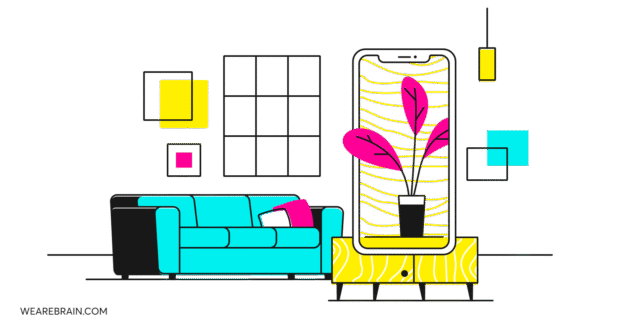
Home decor enthusiasts suffering from buyer’s remorse, rejoice! Finally, you’re saved from the perils of post-purchase regret when reality doesn’t quite live up to the online catalogue.
There’s nothing worse than immediately realising that the sofa, lamp, curtains, etc. you spent hours searching for doesn’t suit the rest of your decor. Especially when the delivery guys have already packed up the truck and are backing out of your driveway, leaving you with a nice-in-catalogue but a not-so-nice-in-reality piece of decor to deal with.
But thanks to the latest AR and VR technologies making their way to the home decor retail space, this scenario is now a thing of the past. In 2025, the AR/VR market has reached $200.87 billion, with the home decor sector driving significant adoption. Customers are fully embracing the benefits of the augmented reality home shopping era that leverages virtual reality showrooms, AR in home decor, VR in interior design, and virtual furniture placement to ensure they see exactly how decor will look in their own space before purchasing.
AR & VR’s role in home decor shopping
Augmented Reality (AR) and Virtual Reality (VR) are spearheading a shift in the way consumers envision and purchase home decor items. The impact these technologies are making on the home decor shopping experience is revolutionising how customers visualise and interact with furniture and decor items before making a purchase.
Pre-visualising furniture and decor with advanced AI integration
AR and VR technologies now enable shoppers to virtually place furniture and decor items in their living spaces with unprecedented accuracy. AI-powered algorithms analyze user data to provide personalized recommendations, identifying patterns and preferences that help platforms suggest content and features most relevant to each customer. This immersive experience allows users to assess how different items complement their existing decor, ensuring a more informed decision-making process.
Enhanced 3D product views and WebAR accessibility
One of the breakthrough developments in 2025 is the rise of WebAR applications. Unlike traditional AR applications that require dedicated hardware and software, WebAR applications can be accessed directly through a web browser, making them more accessible to a wider audience. This increased accessibility has led to a surge in interactive product demos and educational experiences.
The ability to provide 3D product views allows customers to understand the dimensions and fit of furniture items with mathematical precision. This feature bridges the gap between online shopping and the in-store experience, offering a more comprehensive understanding of the products.
Virtual reality showrooms powered by 5G
AR and VR allow shoppers to enjoy interactive home tours and virtual showrooms. The advent of 5G technology has accelerated the growth of AR and VR, with higher data transfer speeds and lower latency enabling more seamless and immersive experiences. These experiences guide purchase decisions by allowing customers to explore different layouts and visualise how various items fit within a space. The result is a more engaging and personalised shopping journey that instils trust in shoppers’ purchasing decisions.
How AR & VR benefits both customers and retailers
The introduction of AR and VR technologies into the home decor retail space appears to be a win-win deal for both shoppers and retailers. Let’s explore the evolved benefits:
Dramatically reduced returns
By leveraging AR and VR for home decor shopping, shoppers are now able to make significantly more informed decisions, which reduces the likelihood of returns by up to 40%. The ability to visualise products in their homes with AI-enhanced accuracy minimises the uncertainty associated with online furniture shopping. Retailers benefit from eliminating the substantial costs of returning items while improving inventory management.
Enhanced customer engagement with AI personalization
For retailers, the integration of AI with AR/VR technologies has created unprecedented engagement opportunities. AI algorithms analyze user behavior patterns to deliver personalized experiences, with platforms like IKEA Place using AI to suggest furniture arrangements based on a user’s room dimensions and style preferences. The interactive nature of these technologies immerses users in captivating shopping experiences, fostering deeper connections with products and ultimately, brands.
Customer confidence through advanced visualization
AR and VR instil unprecedented confidence in customers, helping them overcome traditional hesitation about buying large items online. The visual reassurance provided by these technologies, enhanced by real-time data processing and AI-driven recommendations, helps users feel completely secure in their purchasing decisions. This confidence translates to increased customer loyalty and higher conversion rates.
Great examples of VR & AR in home decor
Here are innovative examples of how brands are leveraging advanced AR and VR technologies to create immersive and informative purchasing journeys in 2025:
Praxis AR Floor Calculator
At WeAreBrain, we developed the Praxis AR Floor Calculator which demonstrates how AR technology can assist users in visualising and planning the type of floor they want to install in their homes. This innovative tool not only enhances the user experience but also aids in space optimisation, helping shoppers make informed decisions before outlying the costs of a new floor.
Advanced IKEA Place with AI integration
IKEA’s AR app now incorporates advanced AI capabilities that go beyond simple furniture placement. The app uses AI to suggest furniture arrangements based on user preferences, room dimensions, and existing decor styles, creating a truly personalized shopping experience.
Wayfair’s enhanced AR ecosystem
Wayfair’s mobile app now features comprehensive AR functionalities that enable customers to visualise furniture and decor items at precise scale within their homes. The enhanced platform includes social features where users can share designs and participate in community voting, earning points for beautiful designs that can be redeemed for discounts.
Navigating 2025 challenges and innovations
While the promise of AR and VR in home decor shopping has been largely realized, several important considerations continue to shape the landscape:
Technical advancement and accessibility
The integration of AI and machine learning has dramatically improved realistic experiences, with AI streamlining the generation of environments and reducing the need for extensive manual work by 3D artists. However, data privacy concerns remain crucial, as AR and VR technologies collect everything from location information to biometric data and behavioral patterns.
User adoption and interface evolution
WebAR has significantly reduced the learning curve by eliminating the need for complicated setups. Users can now dive into AR experiences directly through their web browsers, making the technology more accessible than ever before.
Integration with diverse product catalogs
Modern AR and VR platforms now feature robust solutions for seamless integration with vast arrays of home decor items, powered by cloud computing solutions and big data analytics to understand market trends and consumer preferences.
Immerse before you buy
AR and VR have fundamentally reshaped the landscape of home decor e-commerce, offering shoppers transformative opportunities to visualise and interact with products before making purchase decisions. By 2030, the AR/VR market is expected to reach $589 billion, with home decor and retail leading the charge.
Through dramatically reduced return rates, AI-enhanced engagement, and unprecedented consumer confidence, these technologies have propelled the industry into a new era of possibility. The ongoing integration of artificial intelligence, 5G connectivity, and WebAR accessibility continues to enrich the home decor shopping experience, making it more immersive, personalised, and satisfying for shoppers worldwide.
As technology continues to evolve, the synergy between augmented and virtual realities and home decor is set to redefine the future of online furniture shopping.
